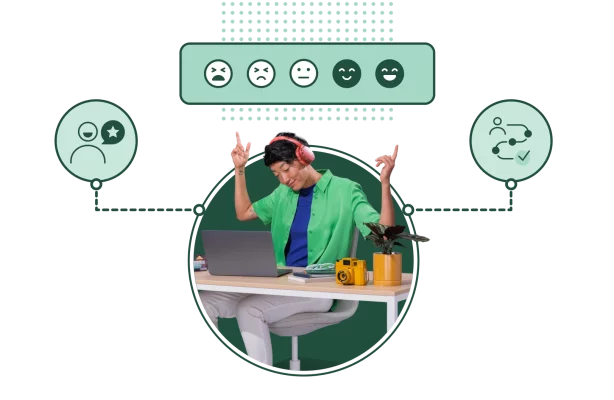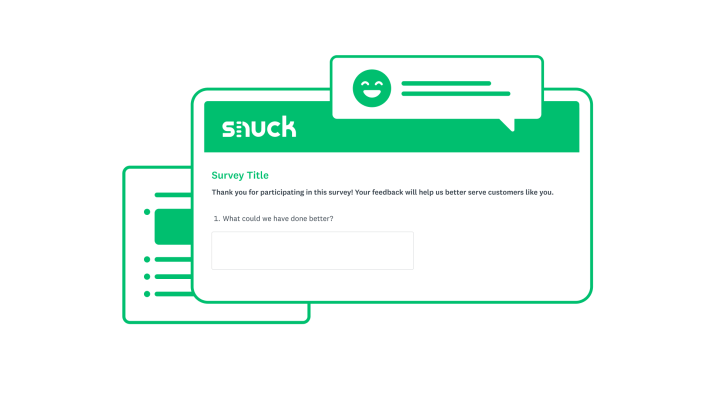How to follow up with NPS detractors, promoters, and passives
How to engage with Net Promoter Score (NPS) detractors, promoters, and passives to boost customer satisfaction.

Net Promoter Score® (NPS) is a method to assess customer loyalty, and many businesses today consider it an important metric. But establishing an NPS is just the beginning—what matters is what you do with your NPS survey results.
Haven’t started capturing NPS yet? Use this free template to build your NPS survey.
NPS allows you to identify your promoters, passives, and detractors, but once you know who they are, it’s time to follow up. You’ll need to go beyond sending out an NPS survey to engage customers effectively. Genuine engagement means following up on each response to show your appreciation for the feedback while gathering more information and finding opportunities to connect.
Following up on an NPS survey will help boost customer satisfaction and loyalty—ultimately leading to more referrals, renewals, and revenue.
The NPS survey follow-up strategy
First and foremost, you’ll want to ensure that the NPS survey responses aren’t anonymous because you’ll need to be able to identify your customers in order to contact them.
How to follow up
The channel you use for your outreach depends on your business and your relationship with your customers. Try to stick to the same communication channel where the conversation began. For example, did you send your NPS survey via email? If so, follow up on their survey response via email.
When to follow up
It’s important that you follow up on NPS responses in a timely manner. Sooner is better for most survey follow-ups, but within a week is often a reasonable timeframe. Much longer than that, and the rating won’t be fresh in the customer’s mind anymore, and you’ll have lost the connection. A timely response is especially important if a customer gives you a poor rating due to a negative experience. Responding quickly can help you resolve the issue before it’s too late.
Who should follow up
While many teams might be able to handle this process, a customer-facing success or support team can capitalize on their relationship-building skills and product knowledge to make NPS survey follow-ups a success. If you have managed accounts, then it’s also a good idea to notify the primary point of contact.
How to start the conversation with your customers
Kickstart the conversation by asking your customers for more details alongside their ratings from within the NPS survey. Open-ended questions like “Why did you choose this rating?” or “What would move you just one point higher?” can give you important context on your customer’s experience and lead to more effective outreach.

If you’re curious about specific areas of your business, you can also ask follow-up questions requesting that customers rate their satisfaction on dimensions like the quality of customer support, product features, and purchasing experience. Just be careful not to overload them with too many answer options, which can have a negative effect on response rates.
Armed with knowledge from these additional questions, you’ll be able to build a more personalized approach based on the customer’s response and their categorization as a promoter, passive, or detractor.
And don’t forget that regardless of the NPS scores, there’s one thing that every customer will want to hear: thank you. Start each conversation by letting them know you appreciate the time and thought they put into your NPS survey, and that you value their feedback. From there, you can adjust your message based on the customer’s specific score and commentary.
How to follow up with NPS promoters
NPS promoters are your brand’s advocates, and they’ll be thrilled to hear from you.
Following up with promoters will amplify the positive experience they’ve already had, motivate them to endorse you, and open up a line of communication in case they ever need anything down the road.
Conversations with promoters can be particularly rewarding because they’re likely to be positive. And since they said they’d be likely to recommend you, you should take the opportunity to encourage them to do it.
Here are a few best practices for following up with NPS promoters.
Give them instructions on how to refer friends and family
For example, if they have a unique referral code that will earn them perks with your business, then make sure they know about it.
At the end of your survey or in your follow-up, you can say something like:
Did you know you can earn free months of service by referring your friends and family? Every time someone joins by using your invite (which you can find here), you’ll get one free month!
Ask them to share their experience
You can also encourage your NPS promoters to share their experience on social media or review your business on the channels that are important to you. Depending on your business, you might also ask them for a case study or testimonial that you can use on your website and social media channels.
For an added incentive, consider giving something away to a randomly selected customer who provides a review. Here is an example of how you can make this suggestion:
We’re so happy to hear that you’d recommend us to your friends and family! We’d love a public review on our Facebook page to help show other customers what we’re all about. Bonus: We’re giving away a free month of service to ten customers who review us this month!
Personalize your responses
Be sure to acknowledge specific details that your customers mentioned in their responses. For example, if they’re really excited about a new feature you launched, then tell them you’re excited about it too and link them to a resource about it, or let them know what’s up next.
Open the lines of communication
Make sure NPS promoters know your door is always open for feedback in the future. You can say something like:
Thanks for taking the time to respond to our NPS survey. We’re happy to hear that you’d recommend us to your friends and family! If there’s ever anything we can do to help, please don’t hesitate to get in touch.
How to follow up with NPS passives
NPS passives are neutral. They’re right in the middle, and this is your chance to earn their loyalty. While some passive customers may not have been motivated enough to proactively contact you with their questions or problems, being prompted with a follow-up from you will inspire them to engage, giving you a space to address their needs and move them from passive to promoter.
Here are a few best practices for following up with NPS passives:
Ask for more details
When passive customers haven’t given you any qualitative information, ask for more so you know what you can do to help. They may not have mentioned anything in the NPS survey, but that could be because they weren’t sure that anyone cared. Reaching out to ask again shows them you’re truly interested in learning more, and that you’re available to assist.
See the example below:
Hi Eric! I’m from Company X, and I received your NPS response yesterday. Thank you so much for responding! What could we do to improve your experience? We take customer feedback seriously, and yours will help us make our business better for everyone. If you have a moment, we’d love to hear more from you.
Act on their feedback
When you hear back, or if you’re responding to a passive customer who has already left you a comment, take action! Based on what you hear, you may be able to provide information about features they missed, show them how to use your product or service in a better way, or give them insight into upcoming roadmap items that will address their needs.
How to follow up with NPS detractors
Engaging with NPS detractors is extremely important because these customers are at high risk of churning. A low NPS score is a warning, but it’s also a chance to resolve issues and win your customer back. In fact, 95% of customers will give you a second chance if you handle their complaint successfully and in a timely manner. Even if the customer ends up churning, a follow-up conversation with them can at least leave them feeling heard and respected, increasing the likelihood that they’ll be back in the future.
Connecting with detractors can also help prevent negative word-of-mouth. It’s an opportunity to address their problem and show them you care. And when that happens, they’ll be far less likely to complain to friends and family.
Ask for more details
As with passive customers, if your detractor hasn’t left any commentary with their score, then try to get more details. They may not have expected anyone to review their feedback. Hearing from you may be a pleasant surprise that gives them the confidence to fill you in on their issue in the hope that you’ll help fix it. See below for an example:
Thanks for responding to our NPS survey. We’re sorry to hear that you wouldn’t recommend us, and we’d love an opportunity to learn more about what we could do to improve. What could we be doing better?
Acknowledge their experience
Once you have sufficient information, start by acknowledging the negative experience. It may not always be that you’ve made a mistake, but you can almost always sympathize with the challenge the customer has faced. Doing this shows the customer that you’re aligned with them, that you’re on their side and ready to help.
Work on a solution
Like passives, detractors may simply need education on the product, but they’re also more likely to have encountered a problem, like a bug or service failure. Take steps to resolve it and let them know what your team will be doing to prevent a similar experience in the future.
Be upfront
In some cases, your solution may be far down the road. When that happens, be upfront, then reach out to them in the future to let them know what you fixed or changed as a result of their input. Here is an example:
A while back, you responded to our NPS survey with some insights and a request to change our billing options. I’m happy to announce that we’ve made some exciting changes as a result of feedback from customers like you. You can read more about them on our blog!
Final words on NPS follow-up
While there is some work involved in following up with NPS survey responses, the extra effort is worth it when it means connecting with your customers, increasing referrals, and driving down churn. And providing the best customer experience possible will, in turn, help you grow your business.
Net Promoter® and NPS® are registered trademarks of Bain & Company, Inc., Satmetrix Systems, Inc., and Fred Reichheld.
Discover more resources

Customer satisfaction survey templates
Explore our customer satisfaction survey templates to rapidly collect data, identify pain points, and improve your customer experience.

3 ways to boost business growth by connecting SurveyMonkey and HubSpot
See how users are taking action on survey data to improve customer experience with the SurveyMonkey app for HubSpot.

How to use Forms to enhance your survey experience
How do surveys and forms differ? Learn how to combine form data with survey feedback for seamless events and experiences.

Beyond CX: How SurveyMonkey + Salesforce turn feedback into revenue
SurveyMonkey + Salesforce turn feedback into revenue